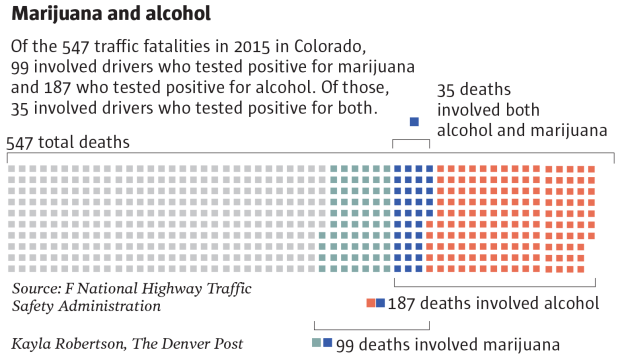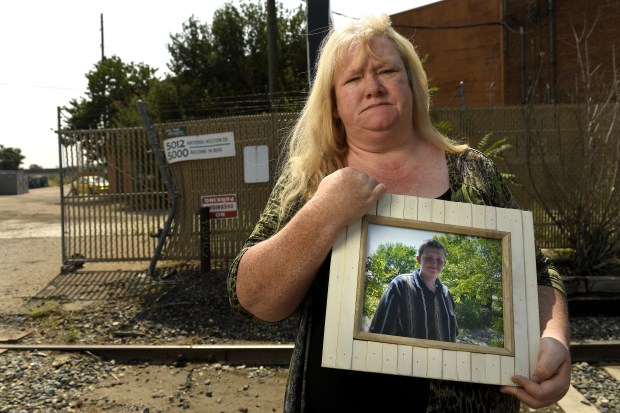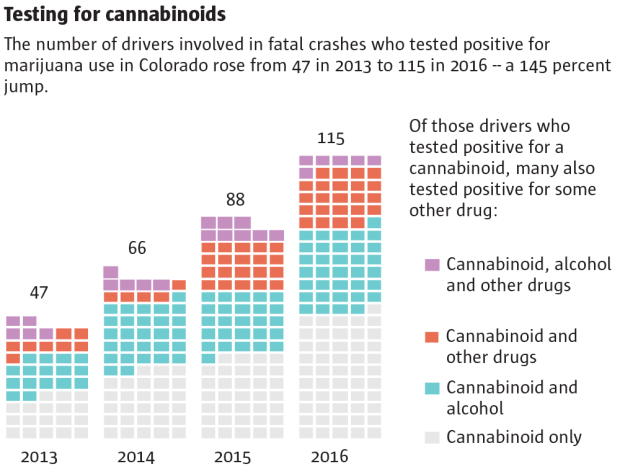The number of drivers involved in fatal crashes in Colorado who tested positive for marijuana has risen sharply each year since 2013, more than doubling in that time, federal and state data show. A Denver Post analysis of the data and coroner reports provides the most comprehensive look yet into whether roads in the state have become more dangerous since the drug’s legalization.
Related:Are you high? The science of testing for marijuana impairment still evolving
Increasingly potent levels of marijuana were found in positive-testing drivers who died in crashes in Front Range counties, according to coroner data since 2013 compiled by The Denver Post. Nearly a dozen in 2016 had levels five times the amount allowed by law, and one was at 22 times the limit. Levels were not as elevated in earlier years.
The vast majority of drivers who survived and tested positive for marijuana use — last year it was 100 percent — were found to have the drug at levels that indicated use within a few hours of being tested, according to the Colorado Department of Transportation, which compiles information for the National Highway Traffic Safety Administration’s Fatality Analysis Reporting System.
The trends coincide with the legalization of recreational marijuana in Colorado that began with adult use in late 2012, followed by sales in 2014. Colorado transportation and public safety officials, however, say the rising number of pot-related traffic fatalities cannot be definitively linked to legalized marijuana.
Positive test results reflected in the NHTSA data do not indicate whether a driver was high at the time of the crash since traces of marijuana use from weeks earlier also can appear as a positive result.
But police, victims’ families and safety advocates say the numbers of drivers testing positive for marijuana use — which have grown at a quicker rate than the increase in pot usage in Colorado since 2013 — are rising too quickly to ignore and highlight the potential dangers of mixing pot with driving.
“We went from zero to 100, and we’ve been chasing it ever since,” Greenwood Village Police Chief John Jackson said of the state’s implementation of legalized marijuana. “Nobody understands it and people are dying. That’s a huge public safety problem.”
The 2013-16 period saw a 40 percent increase in the number of all drivers involved in fatal crashes in Colorado, from 627 to 880, according to the NHTSA data. Those who tested positive for alcohol in fatal crashes from 2013 to 2015 — figures for 2016 were not available — grew 17 percent, from 129 to 151.
By contrast, the number of drivers who tested positive for marijuana use jumped 145 percent — from 47 in 2013 to 115 in 2016. During that time, the prevalence of testing drivers for marijuana use did not change appreciably, federal fatal-crash data show.
And the numbers probably are even higher.
State law does not require coroners to test deceased drivers specifically for marijuana use in fatal wrecks — some do and some don’t — and many police agencies say they don’t pursue cannabinoid tests of a surviving driver whose blood alcohol level is already high enough to charge them with a crime.
“I never understood how we’d pass a law without first understanding the impact better,” said Barbara Deckert, whose fiancée, Ron Edwards, was killed in 2015 in a collision with a driver who tested positive for marijuana use below the legal limit and charged only with careless driving. “How do we let that happen without having our ducks in a row? And people are dying.”

Among The Post’s other findings:
- Marijuana is figuring into more fatal crashes overall. In 2013, drivers tested positive for the drug in about 10 percent of all fatal crashes. By 2016, it was 20 percent.
- More drivers are testing positive for marijuana and nothing else. Of the drivers involved in fatal crashes in 2014 who tested positive for cannabinoids, more than 52 percent had no alcohol in their system. By 2016, it had grown to 69 percent.
- The average age of drivers in deadly crashes in 2015 who tested positive for marijuana was nearly 35, with a quarter of them over 40.
- In 2016, of the 115 drivers in fatal wrecks who tested positive for marijuana use, 71 were found to have Delta-9 tetrahydrocannabinol, or THC, the psychoactive ingredient in marijuana, in their blood, indicating use within hours, according to state data. Of those, 63 percent were over 5 nanograms per milliliter, the state’s limit for driving.

“We are discouraged by the rising numbers. We had awareness campaigns four months after legalization and thought we were getting out ahead of it,” said Sam Cole, spokesman for the traffic safety division of the Colorado Department of Transportation, where the FARS data for the state is collected.
Pointing to a number of different studies, the industry counters that the data is imprecise and does not definitively link fatal crashes to marijuana use.
“Unlike alcohol, THC can remain detectable in the blood stream for days or weeks, when any impairment wears off in a matter of hours,” said Taylor West, former deputy director of the National Cannabis Industry Association. “So all those numbers really tell us is that, since legal adult-use sales began, a larger number of people are consuming cannabis and then, at some point … (are) driving a car.”
Estimates vary for how much marijuana use has increased in Colorado since legalization. Surveys by the federal Substance Abuse and Mental Health Services Administration found that use within 30 days rose from about 12 percent of Colorado adults in 2013 to 17 percent in 2015, a 42 percent increase. But the Colorado Department of Public Health and Environment published a survey last year putting adult use at 13 percent in 2015, indicating a slower rate of growth.
The number of drivers involved in fatal crashes testing positive for marijuana rose 88 percent from 2013 to 2015, FARS data show. The numbers are not strictly comparable as the usage estimates would take into account Colorado’s population growth rate of roughly 1.8 percent a year.
A tragic joyride
It was just past 2 a.m. on Jan. 13, 2016, when Cody Gray, 19, and his running buddy, Jordan Aerts, 18, were joyriding around north Denver in a car they had stolen a few hours earlier.
Ripping south along Franklin Street, where it curves hard to the right onto National Western Drive, Gray lost control, drove through a fence and went straight onto the bordering railroad tracks. The car rolled and Gray was ejected.
An autopsy on Gray later found he had 10 ng/mL of Delta-9 THC in his system, twice the legal limit.
Corina Triffet, Gray’s mother, said she never knew about the test results until The Post called.
“There’s just no limit on what they can take, whether it’s smoking it or edibles,” she said. “I just can’t imagine people are getting out there to drive when they’re on it. But my son apparently did, and there it is.”

Law enforcement officials, prosecutors and public policy makers concede there’s still too little information about marijuana and how it’s detected to understand just how much the drug is affecting traffic fatalities. Even coroners who occasionally test for the drug bicker over whether to include pot on a driver’s death certificate.
“No one’s really sure of the broad impact because not all the drivers are tested, yet people are dying,” said Montrose County Coroner Dr. Thomas Canfield. “It’s this false science that marijuana is harmless, … but it’s not, particularly when you know what it does to your time and depth perception, and the ability to understand and be attentive to what’s around you.”
Critics see the data as proving Colorado moved too fast in legalizing the drug without first understanding its impact behind the wheel – as if handing over the keys to the car without knowing who was driving.
“Colorado has chosen not to measure the outcomes of legalized marijuana, paying more attention to the commercialization,” said Ed Wood of DUID (Driving Under the Influence of Drugs) Victim Voices, an organization he founded after his son’s traffic death caused by a drugged driver. “People have referenced this as the grand experiment, … and the only outcome they measure is the tax revenue, and that’s shameful and a disgrace.”
The Colorado State Patrol said officers believed marijuana was a factor in more than 17 percent of all DUI arrests they made in 2016. The year before, it was about 13 percent. In the first six months of 2017, it was at 14.5 percent, although the number of fatal crashes in which alcohol and drugs were a factor has increased by 28 percent.
“We’ve definitely seen an increase in the number of DUI cases in which marijuana is involved,” said Rich Orman, deputy district attorney for the 18th Judicial District covering Arapahoe, Douglas, Lincoln and Elbert counties. “And that’s been just since the legalization of recreational marijuana.”
Proponents of legalization say it’s too early to tell whether marijuana is the culprit in the rising numbers of fatalities in which a driver tested for use of the drug, and that additional years of data are required before any conclusions can be drawn.
“(The state’s) analysis on crash data … acknowledges an increase in crashes in Colorado. However, the increase is not specifically attributed to cannabis,” said Kristi Kelly, executive director of the Colorado-based Marijuana Industry Group.
Unlike alcohol, which offers decades of scientific research and traffic data toward an understanding of its impact on a person’s ability to drive, marijuana’s effect is still a mystery. No one’s really sure how it impacts the cognitive functions necessary to drive a car safely, or how much is too much for different people.
Federal data about fatal crashes only indicate the presence of the drug, not whether it’s Delta-9 THC or one of its harmless metabolites that linger long after the drug is ingested, sometimes for weeks. Delta-9 THC interacts with brain receptors, producing the “high” associated with marijuana use. The metabolites found in a urine test, for example, are only indicative of past use while Delta-9 reflects more recent use, often in just the past few hours.
“There needs to be better understanding about what constitutes impairment,” Kelly said.
Trends similar in WA
The trends in the state appear nearly identical in Washington state, where recreational marijuana was legalized at about the same time. Officials there have been tracking the drug’s impact on driving much more carefully and for a longer period, statistics show.
What Washingtonians have been seeing is starting to be revealed here: “Drug-impaired driving is now eclipsing alcohol, and that’s frustrating,” said Darrin Grondel, director of Washington’s Traffic Safety Commission, which is gathering and studying the data.
However, Colorado’s understanding is due to deepen. The legislature last session passed House Bill 1315, which mandates a vigorous analysis of traffic fatalities statewide and the extent to which marijuana and other drugs are involved and prosecuted. As part of that project, state police have re-analyzed about a third of blood samples taken from suspected drunk drivers in 2015 and, according to a person familiar with that project, found that more than three in five also tested positive for active THC.
Coroners and police say they have no idea just how many drivers – dead or alive – have active THC in their system because so few of them are tested for it in the first place.
Colorado’s Department of Public Safety in March 2016 said barely half of all drivers involved in fatal crashes were tested for drugs – and 81 percent of the ones tested were dead. That has remained relatively unchanged since 2012, when 45 percent of all drivers in fatal crashes were tested. That’s because Colorado’s DUI laws are such that a positive reading for alcohol impairment quickly results in a suspended license.
Not so for marijuana.
“We test for alcohol, and when we get a reading, then we don’t bother with the marijuana,” said Lt. Robert Rock of the Denver Police Department’s traffic investigations division. “That’s a function of the law.”
Greenwood Village Chief Jackson agreed: “With alcohol, if you blow (0.08 blood alcohol level), law enforcement is done and doesn’t care about the marijuana there,” he said. “It’s $500 for that test, a two-hour wait, staff time, and it makes little difference if there is marijuana.”
Said Rock: “A lot of departments just can’t afford to do that all the time.”
The vast majority of drivers who survived fatal crashes and were tested for cannabinoids showed they had used the drug within hours of testing. In 2016, for example, all 22 of the surviving drivers suspected of marijuana impairment tested positive for levels of Delta-9 THC — and seven of them at levels deemed illegal to drive.
It was nearly the same in 2015, The Post found, with 18 of 22 drivers who survived a crash testing positive for Delta-9 THC. Five of them tested at or above 5 ng/mL, the legal limit.
The biggest testing lab in the state — ChemaTox in Boulder — is finding the same trend. The lab has found that of the tests that were positive for marijuana use, more than 80 percent were for active THC, indicating use within hours of when the sample was taken.

Aside from a lack of consistent testing, the numbers are probably even higher because of incomplete federal data, experts say.
The federal FARS traffic data only log up to three drugs found in the body of someone killed in a crash, even if there were more. Sometimes marijuana doesn’t make the FARS report. And any death that happens on private property or doesn’t involve a moving vehicle is not included in the FARS system.
Also, FARS records only the presence of the drug — not its potency; how recently it had been used; whether it was a factor in the crash; and whether the driver who tested positive was at fault or even ticketed.
“That doesn’t mean we should dismiss any concern about cannabis-impaired driving,” NCIA’s Taylor said, “but it does mean we should be very careful about what gets read into data that doesn’t actually give us any specific insight into the issue.”
Transportation officials are concerned not only with pot-related fatalities but with the overall rise in traffic deaths. While CDOT doesn’t see the number of drivers involved in fatal crashes as “a reliable measurement,” preferring metrics such as the number of actual crashes and fatalities, it does note that those are also on the rise.
The reason, said CDOT’s Cole, is probably due in part to an increase in motorcycle fatalities, pedestrian deaths, cellphone use — and marijuana.
“But how much remains a mystery until CDOT obtains better data on the type of THC involved in fatal crashes,” Cole said. “Only crashes involving an at-fault driver with active THC can be attributed to marijuana use. Currently, most toxicology results do not include this.”
Higher levels of THC
Coroners began seeing a troubling trend last year: Toxicology tests on dead drivers were revealing higher levels of Delta-9 THC.
In Denver, THC levels were reading as high as 24 ng/mL, with one hitting 68, coroner records obtained by The Post show.
In Boulder, 18-year-old Quinn Hefferan admitted to smoking marijuana just before falling asleep behind the wheel on May 7, 2016, and crashing into another car killing two people. Records show Hefferan had 20 ng/mL of THC in his system – four times the legal limit.
It was worse in Adams County, The Post found.
THC levels in drivers killed in crashes in 2016 routinely reached levels of more than 30 ng/mL, records show. The year before, levels only occasionally topped 5 ng/mL, records show.
Coroners’ records along the Front Range show the same trend.
“Potency is the extreme problem, with an extreme lack of understanding about what today’s marijuana really is,” Police Chief Jackson said. “This is not your grandfather’s weed. It’s not even marijuana; it’s THC, oils and concentrates, at levels of acute overdose. That’s what seems to be driving these numbers so high.”
Still, because of the uncertainty around what constitutes impairment, coroners don’t agree on whether the presence of THC should be listed on a death certificate.
“One of the three contract physicians I have is adamantly opposed to have it listed on there,” said Jill Romann, Douglas County’s coroner. “There are others across the state who feel the same way and won’t use the word intoxication with it. Despite the fact we are all coroners, everyone does as they want.”
In a crash that killed three teenagers on a curvy, two-lane road near Conifer in May 2016, they ran straight off a turn, down an embankment and into a creek, flipping several times.
Along with another teenager, the four had just finished the school year at St. John’s Military Academy in Salinas, Kan., and were heading to a camping trip. They had spent the night before at the Colorado home of Mark Yoder, the father of one of the boys killed.
“It didn’t take anything but a couple of hours, from them being alive to not alive,” Yoder said of his 19-year-old son, John, and his companions, Jake Whitting, 18, of Glen Head on New York’s Long Island, and Akinwumi “AH” Ricketts, 16, of Nigeria.
Ricketts was to spend a few weeks with the Yoders.
The fourth student, then-17-year-old Marshall Otter, of Kansas, survived.
Yoder said he didn’t know that the Jefferson County coroner’s office had detected marijuana in all three young men. Reports show the driver, Whitting, had 8.5 ng/mL of Delta-9 THC.
Along with marijuana in all three, the coroner also found levels of Xanax, an anti-anxiety drug that is sometimes mixed with marijuana for the specific high it creates.
“I just don’t understand why they’d have done any of that,” Yoder said of the drugs. “It makes no sense. And then drive?”
